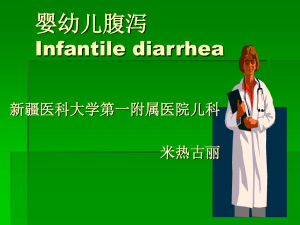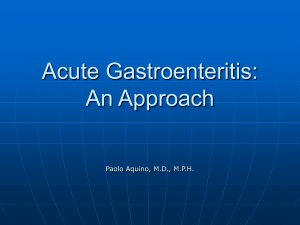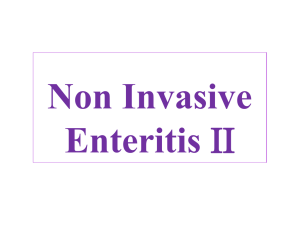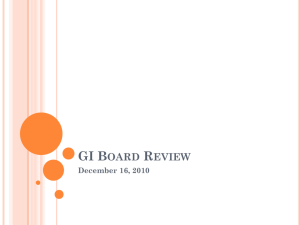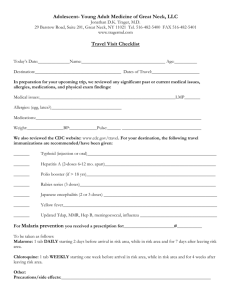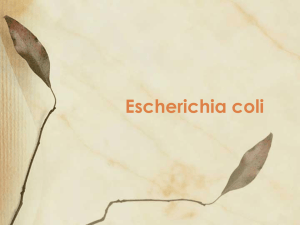Epidemiology and Management of Diarrheal Diseases
advertisement
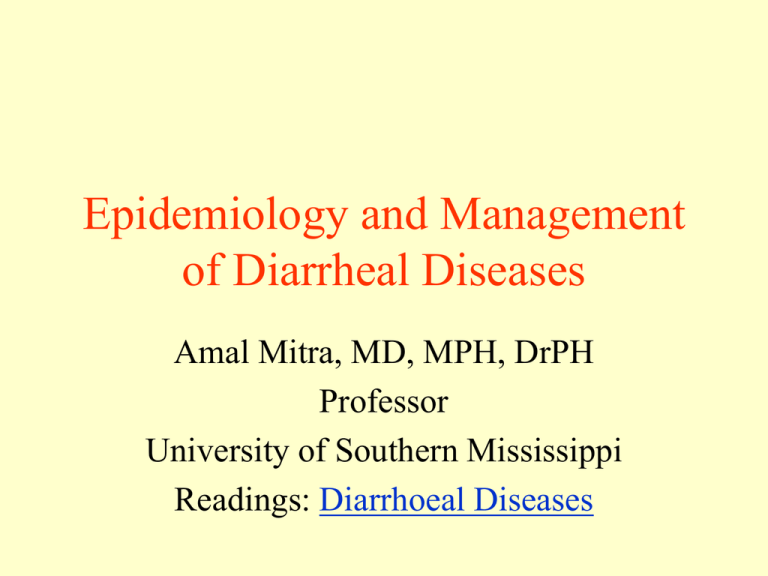
Epidemiology and Management of Diarrheal Diseases Amal Mitra, MD, MPH, DrPH Professor University of Southern Mississippi Readings: Diarrhoeal Diseases DEFINITION • Watery Diarrhea: 3 or more liquid or watery stools in 24 h • Dysentery: Presence of blood and/or mucus in stools • Persistent Diarrhea: Diarrhea lasting for 14 days or more TYPES OF DIARRHEA Diarrhea Watery diarrhea Dysentery Persistent diarrhea Rota virus diarrhea E. coli diarrhea Cholera Shigellosis Amebiasis Causes are mostly unknown COMMON CAUSES OF DIARRHEA- BACTERIA – – – – – – – – – Vibrio cholera Shigella Escherichia coli Salmonella Campylobacter jejuni Yersinia enterocolitica Staphylococcus Vibrio parahemolyticus Clostridium difficile COMMON CAUSES OF DIARRHEA- VIRUS • • • • • Rotavirus Adenoviruses Caliciviruses Astroviruses Norwalk agents and Norwalk-like viruses COMMON CAUSES OF DIARRHEA- PARASITE • • • • Entameba histolytica Giardia lamblia Cryptosporidium Isospora COMMON CAUSES OF DIARRHEA-OTHERS • Metabolic disease Hyperthyroidism Diabetes mellitus Pancreatic insufficiency • Food allergy Lactose intolerance • Antibiotics • Irritable bowel syndrome TRANSMISSION • Most of the diarrheal agents are transmitted by the fecal-oral route • Some viruses (such as rotavirus) can be transmitted through air • Nosocommial transmission is possible • Shigella (the bacteria causing dysentery) is mainly transmitted person-to-person SEASONALITY Disease Common season Cholera Winter Rotavirus diarrhea Winter Shigellosis Dry summer PERSON-AT-RISK • Cholera: 2 years and above, uncommon in very young infants • Shigellosis: more common in young children aged below 5 years • Rotavirus diarrhea: more common in young infants and children aged 1-2 years • E. coli diarrhea: can occur at any age • Amebiasis: more common among adults TYPES OF VIBRIO CHOLERA • Two major biotypes of Vibrio cholera that cause diarrhea are: Classical ElTor • Two common serotypes of Vibrio cholera that cause diarrhea are: Inaba Ogawa Vibrio cholerae O139 • Vibrio cholerae in O-group 139 was first isolated in 1992 and by 1993 had been found throughout the Indian subcontinent. This epidemic expansion probably resulted from a single source after a lateral gene transfer (LGT) event that changed the serotype of an epidemic V. cholerae O1 El Tor strain to O139. • More information: http://www.cdc.gov/ncidod/EID/vol9no7/020760.htm Vibrio vulnificus • The organism Vibrio vulnificus causes wound infections, gastroenteritis or a serious syndrome known as "primary septicema." • V. vulnificus infections are either transmitted to humans through open wounds in contact with seawater or through consumption of certain improperly cooked or raw shellfish. • This bacterium has been isolated from water, sediment, plankton and shellfish (oysters, clams and crabs) located in the Gulf of Mexico, the Atlantic Coast as far north as Cape Cod and the entire U.S. West Coast. • Cases of illness have also been associated with brackish lakes in New Mexico and Oklahoma. • For more information: http://hgic.clemson.edu/factsheets/HGIC3663.htm TYPES OF SHIGELLA • The major serotypes of Shigella that cause diarrhea are: Dysenteriae type 1 or Shigella shiga Shigella flexneri Shigella sonnei Shigella boydii TYPES OF E. COLI • Six major types of Escherichia coli cause diarrhea: Enterotoxigenic E. coli (ETEC) Enteroinvasive E. coli (EIEC) Enteropathogenic E. coli (EPEC) Enterohemorrhagic E. coli (E. coli O157:H7) Enteroaggregative E. coli (EAggEC) Diffuse adherent E. coli (DAEC) CLINICAL FEATURE: CHOLERA • • • • • • • Rice-watery stool Marked dehydration Projectile vomiting No fever or abdominal pain Muscle cramps Hypovolemic shock Scanty urine CLINICAL FEATURE: E. COLI DIARRHEA • • • • • Watery stools Vomiting is common Dehydration moderate to severe Fever– often of moderate grade Mild abdominal pain CLINICAL FEATURE: ROTAVIRUS DIARRHEA • Insidious onset • Prodromal symptoms, including fever, cough, and vomiting precede diarrhea • Stools are watery or semi-liquid; the color is greenish or yellowish– typically looks like yoghurt mixed in water • Mild to moderate dehydration • Fever– moderate grade CLINICAL FEATURE: SHIGELLOSIS • Frequent passage of scanty amount of stools, mostly mixed with blood and mucus • Moderate to high grade fever • Severe abdominal cramps • Tenesmus– pain around anus during defecation • Usually no dehydration CLINICAL FEATURE: AMEBIASIS • Offensive and bulky stools containing mostly mucus and sometimes blood • Lower abdominal cramp • Mild grade fever • No dehydration LABORATORY DIAGNOSIS • • • • • Stool microscopy Dark field microscopy of stool for cholera Stool cultures ELISA for rotavirus Immunoassays, bioassays or DNA probe tests to identify E. coli strains ASSESSMENT OF DEHYDRATION Dehydration Mild Moderate Severe Appearance irritable, irritable, lethargy, thirsty very coma, or thirsty unconscious Anterior normal depressed markedly Fontanelle depressed Eyes normal sunken sunken ASSESSMENT OF DEHYDRATION (contd.) Tongue Mild normal Skin normal Breathing normal Dehydration Moderate Severe dry very dry, furred slow very slow retraction retraction rapid very rapid ASSESSMENT OF DEHYDRATION (contd.) Pulse Mild normal Urine normal Dehydration Moderate Severe rapid and feeble or low imperceptible volume dark scanty Weight loss < 5% 6 - 9% 10% or more TREATMENT • Rehydration– replace the loss of fluid and electrolytes • Antibiotics– according to the type of pathogens • Start food as soon as possible COMPOSITION OF ORS Ingredient Sodium chloride Amount (g/liter) 3.5 Trisodium citrate or Sodium bicarbonate 2.9 or 2.5 Potassium chloride 1.5 Glucose 20.0 AMOUNT OF SALT LOSS DURING DIARRHEA Diarrhea Cholera (child) Salt (mmol/L) Na K Cl HCO3 88 30 86 32 Cholera (adult) 135 15 100 45 E. coli Rota virus 53 37 37 24 38 22 18 6 ANTIMICROBIAL AGENTS Type of diarrhea Cholera Antimicrobial agent Tetracycline, Doxycycline, Ciprofloxacine Shigellosis Pivmecillinam (Selexid), Nalidixic acid, Ciprofloxacin, Ceftriaxone Metronidazole Amebiasis COMPLICATIONS: WATERY DIARRHEA • • • • • • Dehydration Electrolyte imbalances Tetany Convulsions Hypoglycemia Renal failure COMPLICATIONS: DYSENTERY • • • • • • • • Electrolyte imbalances Convulsions Hemolytic uremic syndrome (HUS) Leukemoid reaction Toxic megacolon Protein losing enteropathy Arthritis Perforation VACCINES • An oral cholera vaccine is available, which gives immunity to 50-60% of those who take the vaccine, and this immunity lasts only a few months. • No vaccines are available against shigellosis • A vaccine against rotavirus diarrhea has been withdrawn recently from the market. PREVENTION • Safe drinking water and food “Boil it, cook it, peel it, or forget it. " • Hand washing • Proper sanitation
